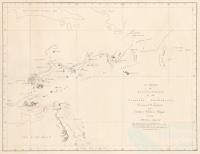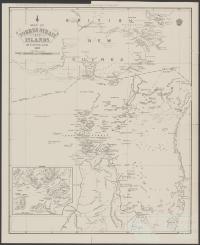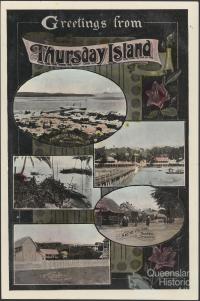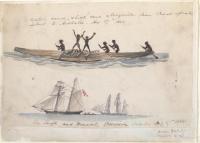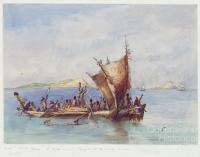- Home
- Quintessential Queensland
- Distinctiveness
- Perceptions
- Perceptions: how people understand the landscape
- From runs to closer settlement
- Geological survey of Queensland
- Mapping a new colony, 1860-80
- Mapping the Torres Strait: from TI to Magani Malu and Zenadh Kes
- Order in Paradise: a colonial gold field
- Queensland atlas, 1865
- Queensland mapping since 1900
- Queensland: the slogan state
- Rainforests of North Queensland
- Walkabout
- Queenslanders
- Queenslanders: people in the landscape
- Aboriginal heroes: episodes in the colonial landscape
- Australian South Sea Islanders
- Cane fields and solidarity in the multiethnic north
- Chinatowns
- Colonial immigration to Queensland
- Greek Cafés in the landscape of Queensland
- Hispanics and human rights in Queensland’s public spaces
- Italians in north Queensland
- Lebanese in rural Queensland
- Queensland clothing
- Queensland for ‘the best kind of population, primary producers’
- Too remote, too primitive and too expensive: Scandinavian settlers in colonial Queensland
- Distance
- Movement
- Movement: how people move through the landscape
- Air travel in Queensland
- Bicycling through Brisbane, 1896
- Cobb & Co
- Journey to Hayman Island, 1938
- Law and story-strings
- Mobile kids: children’s explorations of Cherbourg
- Movable heritage of North Queensland
- Passages to India: military linkages with Queensland
- The Queen in Queensland, 1954
- Transient Chinese in colonial Queensland
- Travelling times by rail
- Pathways
- Pathways: how things move through the landscape and where they are made
- Aboriginal dreaming paths and trading ways
- Chinese traders in the nineteenth century
- Introducing the cane toad
- Pituri bag
- Press and the media
- Radio in Queensland
- Red Cross Society and World War I in Queensland
- The telephone in Queensland
- Where did the trams go?
- ‘A little bit of love for me and a murder for my old man’: the Queensland Bush Book Club
- Movement
- Division
- Separation
- Separation: divisions in the landscape
- Asylums in the landscape
- Brisbane River
- Changing landscape of radicalism
- Civil government boundaries
- Convict Brisbane
- Dividing Queensland - Pauline Hanson’s One Nation Party
- High water mark: the shifting electoral landscape 2001-12
- Hospitals in the landscape
- Indigenous health
- Palm Island
- Secession movements
- Separate spheres: gender and dress codes
- Separating land, separating culture
- Stone walls do a prison make: law on the landscape
- The 1967 Referendum – the State comes together?
- Utopian communities
- Whiteness in the tropics
- Conflict
- Conflict: how people contest the landscape
- A tale of two elections – One Nation and political protest
- Battle of Brisbane – Australian masculinity under threat
- Dangerous spaces - youth politics in Brisbane, 1960s-70s
- Fortress Queensland 1942-45
- Grassy hills: colonial defence and coastal forts
- Great Shearers’ Strike of 1891
- Iwasaki project
- Johannes Bjelke-Petersen: straddling a barbed wire fence
- Mount Etna: Queensland's longest environmental conflict
- Native Police
- Skyrail Cairns (Research notes)
- Staunch but conservative – the trade union movement in Rockhampton
- The Chinese question
- Thomas Wentworth Wills and Cullin-la-ringo Station
- Separation
- Dreaming
- Imagination
- Imagination: how people have imagined Queensland
- Brisbane River and Moreton Bay: Thomas Welsby
- Changing views of the Glasshouse Mountains
- Imagining Queensland in film and television production
- Jacaranda
- Literary mapping of Brisbane in the 1990s
- Looking at Mount Coot-tha
- Mapping the Macqueen farm
- Mapping the mythic: Hugh Sawrey's ‘outback’
- People’s Republic of Woodford
- Poinsettia city: Brisbane’s flower
- The Pineapple Girl
- The writers of Tamborine Mountain
- Vance and Nettie Palmer
- Memory
- Memory: how people remember the landscape
- Anna Wickham: the memory of a moment
- Berajondo and Mill Point: remembering place and landscape
- Cemeteries in the landscape
- Landscapes of memory: Tjapukai Dance Theatre and Laura Festival
- Monuments and memory: T.J. Byrnes and T.J. Ryan
- Out where the dead towns lie
- Queensland in miniature: the Brisbane Exhibition
- Roadside ++++ memorials
- Shipwrecks as graves
- The Dame in the tropics: Nellie Melba
- Tinnenburra
- Vanished heritage
- War memorials
- Curiosity
- Curiosity: knowledge through the landscape
- A playground for science: Great Barrier Reef
- Duboisia hopwoodii: a colonial curiosity
- Great Artesian Basin: water from deeper down
- In search of Landsborough
- James Cook’s hundred days in Queensland
- Mutual curiosity – Aboriginal people and explorers
- Queensland Acclimatisation Society
- Queensland’s own sea monster: a curious tale of loss and regret
- St Lucia: degrees of landscape
- Townsville’s Mount St John Zoo
- Imagination
- Development
- Exploitation
- Transformation
- Transformation: how the landscape has changed and been modified
- Cultivation
- Empire and agribusiness: the Australian Mercantile Land and Finance Company
- Gold
- Kill, cure, or strangle: Atherton Tablelands
- National parks in Queensland
- Pastoralism 1860s–1915
- Prickly pear
- Repurchasing estates: the transformation of Durundur
- Soil
- Sugar
- Sunshine Coast
- The Brigalow
- Walter Reid Cultural Centre, Rockhampton: back again
- Survival
- Survival: how the landscape impacts on people
- Brisbane floods: 1893 to the summer of sorrow
- City of the Damned: how the media embraced the Brisbane floods
- Depression era
- Did Clem Jones save Brisbane from flood?
- Droughts and floods and rail
- Missions and reserves
- Queensland British Food Corporation
- Rockhampton’s great flood of 1918
- Station homesteads
- Tropical cyclones
- Wreck of the Quetta
- Pleasure
- Pleasure: how people enjoy the landscape
- Bushwalking in Queensland
- Cherbourg that’s my home: celebrating landscape through song
- Creating rural attractions
- Festivals
- Queer pleasure: masculinity, male homosexuality and public space
- Railway refreshment rooms
- Regional cinema
- Schoolies week: a festival of misrule
- The sporting landscape
- Visiting the Great Barrier Reef
By:
Maureen Fuary Maps and the power of knowledge
The political significance and inherent power of maps is closely allied with the economic, social and political capital of discovery, exploration and possession. Not surprisingly then, major changes in Indigenous rights and responsibilities in Australia, particularly since the 1980s with the Murray Island Land Case, the Mabo decision and the recognition of Indigenous Native Title, have had a significant impact on the production of maps, and on our perceptions of place and space.
The Torres Strait presents an excellent case to illustrate these dimensions of mapping in Queensland, from the charting of Torres Strait waters in the 1790s to make them safe for European mariners, to the creation of more inclusive maps based on Islander knowledge and nomenclature. We can see how other types of explorers, such as anthropologists and historians, have contributed to the ways in which we have come to perceive and understand different landscapes and seascapes.
Zenadh Kes
In the 1980s, Torres Strait Island voices began to publicly reclaim Torres Strait as theirs, first suggesting the term ‘Magani Malu Kes’ for the region, to more recently urging the adoption of the acronym ‘Zenadh Kes’ to replace the English moniker ‘Torres Strait’.
The late 1890s, and then again from the 1970s to the present, has seen an incremental refinement of the maps of Torres Strait. In the late nineteenth century, the Cambridge Anthropological Expedition to Torres Strait gave Europeans another view of the region. Their published reports included detailed maps of particular islands, drawn by traditional owners and delineating local boundaries and names. Later in the 1970s anthropologists, geographers and oral historians in concert with Torres Strait Island people, developed specific island-based maps which not only recorded traditional place names but connected places and people to cosmology and heroic narratives.
Through these approaches, places on maps had life and a past breathed into them. By having these places named we could see that the islands and reefs had a long and on-going history. This history, known and recounted by the descendants of the original inhabitants, was made visible on these new maps, and in so doing Island people were able to demonstrate their stake in this territory.
During the Border Issue of 1975, with Papua New Guinea poised to attain independence from Australia, Torres Strait Islanders engaged the popular imagination as Queensland’s ‘other’ Indigenous people. The entrenched non-Islander perception of the whole of Torres Strait as being conflated to one island, Thursday Island, or TI, continued unabated. Indeed, for many Queenslanders and Australians alike, TI remains the synecdoche for Torres Strait.
New maps
The first modern Torres Strait regional map which recorded the names for places that each group of Islanders used for their own islands, was produced by Margaret Lawrie in 1970 and has since been refined by many researchers. These were new developments in that earlier maps, which are sometimes still deployed, used a combination of English names as well as bastardised ‘language’ names for places. Then in the late 1990s and into the present, a new generation of mapping emerged: mapping of islands and sea country tied to the evidentiary processes involved in Native Title and particularly the Torres Strait Sea Claim negotiations.
By the start of the twenty-first century, anthropologists in concert with Torres Strait Islanders began deploying satellite imagery, filling up the stunningly beautiful blue-green canvas with Indigenous names for sites, including features above and below the sea. The visual impact and thus the authority generated by such maps (which are not in the public domain), far exceeded their predecessors: the topographic and aerial photographic maps, and the charts. So powerful is their aesthetic and scientific appeal, that the display of one map at a meeting of anthropologists and lawyers in 2001 almost precluded discussion or disagreement. Indeed, there is something about the ways in which we respond to and perceive maps in general, as if they exist sui generis, that ties in with their authority, replicability, and reliability. When this dimension of mapping is married to an appealing aesthetic, their impact, the ways in which delineated boundaries and the density of named places take on their own life force and authenticity, is staggering.
These new and increasingly sophisticated types of map, always in a state of flux and development, embed Torres Strait Island people’s lived experiences, histories and knowledge of the region they have owned and utilised for millennia. They reflect Torres Strait Island peoples’ own perceptions and nomenclature for their homelands, their relationships to each other, their languages, and their use, ownership and significance of place.
Copyright © Maureen Fuary, 2010
Related:
Perceptions 
